Awareness and knowledge about human papillomavirus vaccination and its acceptance in China: a meta-analysis of 58 observational studies
- PMID: 26936076
- PMCID: PMC4776385
- DOI: 10.1186/s12889-016-2873-8
Awareness and knowledge about human papillomavirus vaccination and its acceptance in China: a meta-analysis of 58 observational studies
Abstract
Background: The human papillomavirus (HPV) vaccines have been widely introduced in immunization programs worldwide, however, it is not accepted in mainland China. We aimed to investigate the awareness and knowledge about HPV vaccines and explore the acceptability of vaccination among the Chinese population.
Methods: A meta-analysis was conducted across two English (PubMed, EMBASE) and three Chinese (China National Knowledge Infrastructure, Wan Fang Database and VIP Database for Chinese Technical Periodicals) electronic databases in order to identify HPV vaccination studies conducted in mainland China. We conducted and reported the analysis in accordance with the Preferred Reporting Items for Systematic Reviews and Meta-Analyses (PRISMA) guidelines.
Results: Fifty-eight unique studies representing 19 provinces and municipalities in mainland China were assessed. The pooled awareness and knowledge rates about HPV vaccination were 15.95 % (95 % CI: 12.87-19.29, I (2) = 98.9 %) and 17.55 % (95 % CI: 12.38-24.88, I (2) = 99.8 %), respectively. The female population (17.39 %; 95 % CI: 13.06-22.20, I (2) = 98.8 %) and mixed population (18.55 %; 95 % CI: 14.14-23.42, I (2) = 98.8 %) exhibited higher HPV vaccine awareness than the male population (1.82 %; 95 % CI: 0.50-11.20, I (2) = 98.5 %). Populations of mixed ethnicity had lower HPV vaccine awareness (9.61 %; 95 % CI: 5.95-14.03, I (2) = 99.0 %) than the Han population (20.17 %; 95 % CI: 16.42-24.20, I (2) = 98.3 %). Among different regions, the HPV vaccine awareness was higher in EDA (17.57 %; 95 % CI: 13.36-22.21, I (2) = 98.0 %) and CLDA (17.78 %; 95 % CI: 12.18-24.19, I (2) = 97.6 %) than in WUDA (1.80 %; 95 % CI: 0.02-6.33, I (2) = 98.9 %). Furthermore, 67.25 % (95 % CI: 58.75-75.21, I (2) = 99.8 %) of participants were willing to be vaccinated, while this number was lower for their daughters (60.32 %; 95 % CI: 51.25-69.04, I (2) = 99.2 %). The general adult population (64.72 %; 95 % CI: 55.57-73.36, I (2) = 99.2 %) was more willing to vaccinate their daughters than the parent population (33.78 %; 95 % CI: 26.26-41.74, I (2) = 88.3 %). Safety (50.46 %; 95 % CI: 40.00-60.89, I (2) = 96.6 %) was the main concern about vaccination among the adult population whereas the safety and efficacy (68.19 %; 95 % CI: 53.13-81.52, I (2) = 98.6 %) were the main concerns for unwillingness to vaccinate their daughters.
Conclusions: Low HPV vaccine awareness and knowledge was observed among the Chinese population. HPV vaccine awareness differed across sexes, ethnicities, and regions. Given the limited quality and number of studies included, further research with improved study designis necessary.
Figures
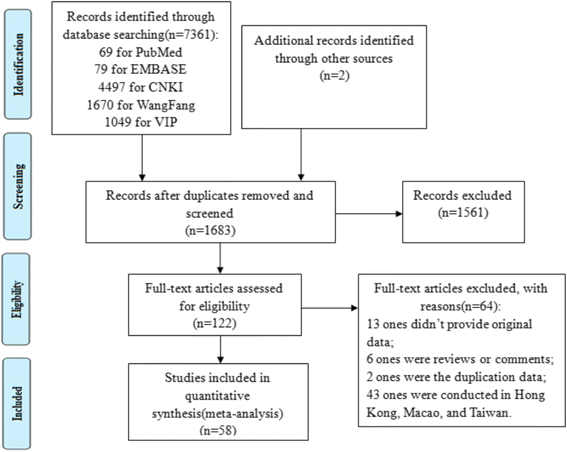
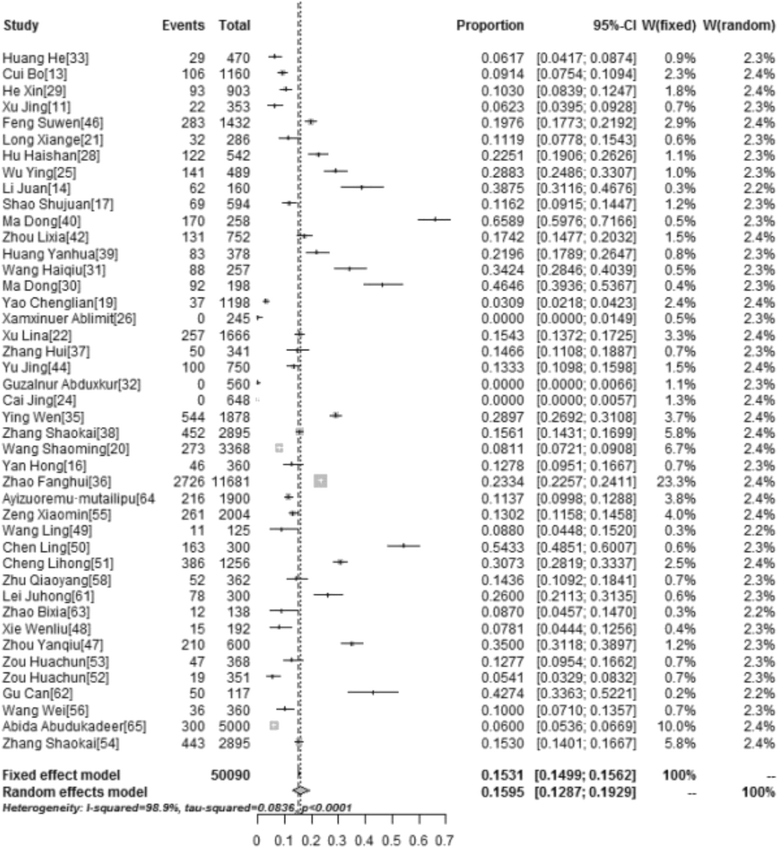
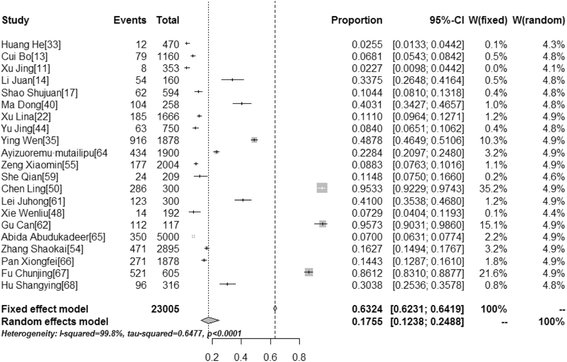
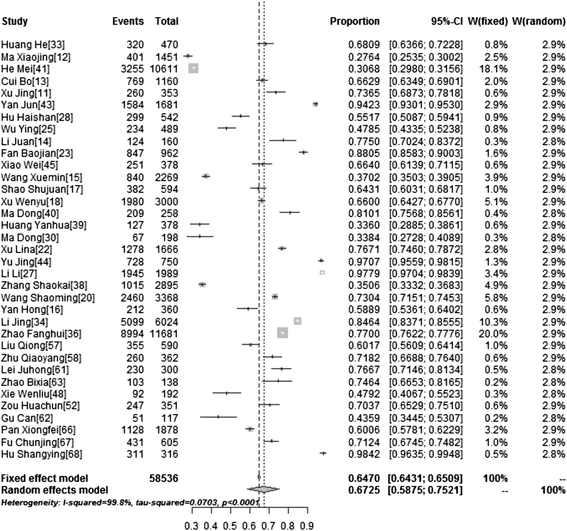
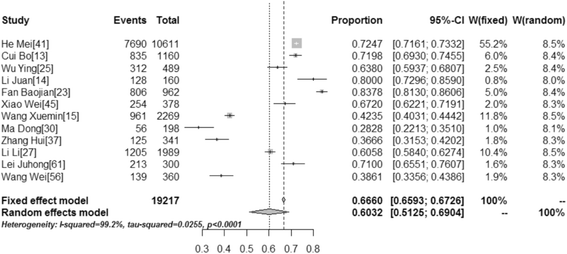
Similar articles
-
Willingness to Accept Human Papillomavirus Vaccination and its Influencing Factors Using Information-Motivation-Behavior Skills Model: A Cross-Sectional Study of Female College Freshmen in Mainland China.Cancer Control. 2021 Jan-Dec;28:10732748211032899. doi: 10.1177/10732748211032899. Cancer Control. 2021. PMID: 34634207 Free PMC article.
-
Global parental acceptance, attitudes, and knowledge regarding human papillomavirus vaccinations for their children: a systematic literature review and meta-analysis.BMC Womens Health. 2024 Sep 27;24(1):537. doi: 10.1186/s12905-024-03377-5. BMC Womens Health. 2024. PMID: 39334328 Free PMC article.
-
Acceptability of human papillomavirus vaccine among parents of junior middle school students in Jinan, China.Vaccine. 2015 May 21;33(22):2570-6. doi: 10.1016/j.vaccine.2015.04.010. Epub 2015 Apr 14. Vaccine. 2015. PMID: 25887088
-
A nationwide post-marketing survey of knowledge, attitude and practice toward human papillomavirus vaccine in general population: Implications for vaccine roll-out in mainland China.Vaccine. 2021 Jan 3;39(1):35-44. doi: 10.1016/j.vaccine.2020.11.029. Epub 2020 Nov 23. Vaccine. 2021. PMID: 33243631
-
Exploring HPV Knowledge, Awareness, Beliefs, Attitudes, and Vaccine Acceptability of Latino Fathers Living in the United States: An Integrative Review.J Community Health. 2019 Aug;44(4):844-856. doi: 10.1007/s10900-019-00636-7. J Community Health. 2019. PMID: 30847716
Cited by
-
Promoting HPV vaccination on social media: interactive effects of threat, efficacy and social cues.Hum Vaccin Immunother. 2021 Nov 2;17(11):4442-4456. doi: 10.1080/21645515.2021.1975449. Epub 2021 Oct 8. Hum Vaccin Immunother. 2021. PMID: 34623229 Free PMC article.
-
Perceptions and acceptability of HPV vaccination among parents of female adolescents 9-14 in China: A cross-sectional survey based on the theory of planned behavior.Hum Vaccin Immunother. 2023 Aug 1;19(2):2225994. doi: 10.1080/21645515.2023.2225994. Epub 2023 Jun 20. Hum Vaccin Immunother. 2023. PMID: 37340698 Free PMC article.
-
Effect of an educational intervention on human papillomavirus (HPV) knowledge and attitudes towards HPV vaccines among healthcare workers (HCWs) in Western China.Hum Vaccin Immunother. 2021 Feb 1;17(2):443-450. doi: 10.1080/21645515.2020.1780093. Epub 2020 Jul 21. Hum Vaccin Immunother. 2021. PMID: 32692948 Free PMC article.
-
Knowledge, attitudes and perceptions regarding human papillomavirus among university students in Hail, Saudi Arabia.PeerJ. 2022 Mar 23;10:e13140. doi: 10.7717/peerj.13140. eCollection 2022. PeerJ. 2022. PMID: 35345591 Free PMC article.
-
Knowledge, attitudes, and perceptions associated with HPV vaccination among female Korean and Chinese university students.BMC Womens Health. 2022 Feb 23;22(1):51. doi: 10.1186/s12905-022-01624-1. BMC Womens Health. 2022. PMID: 35197031 Free PMC article.
References
-
- Levine OS, Bloom DE, Cherian T, de Quadros C, Sow S, Wecker J, Duclos P, Greenwood B. The future of immunisation policy, implementation, and financing. Lancet. 2011;378(9789):439–48. - PubMed
Publication types
MeSH terms
Substances
LinkOut - more resources
Full Text Sources
Other Literature Sources
Medical

